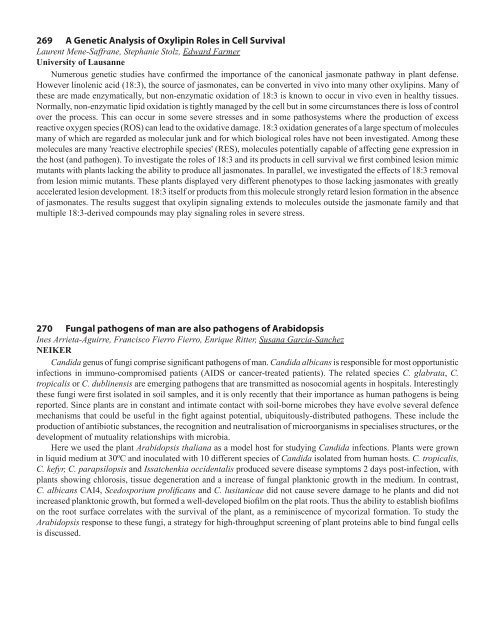75 Integrating Membrane Transport with Male Gametophyte ... - TAIR
75 Integrating Membrane Transport with Male Gametophyte ... - TAIR
75 Integrating Membrane Transport with Male Gametophyte ... - TAIR
Create successful ePaper yourself
Turn your PDF publications into a flip-book with our unique Google optimized e-Paper software.
269 A Genetic Analysis of Oxylipin Roles in Cell Survival<br />
Laurent Mene-Saffrane, Stephanie Stolz, Edward Farmer<br />
University of Lausanne<br />
Numerous genetic studies have confirmed the importance of the canonical jasmonate pathway in plant defense.<br />
However linolenic acid (18:3), the source of jasmonates, can be converted in vivo into many other oxylipins. Many of<br />
these are made enzymatically, but non-enzymatic oxidation of 18:3 is known to occur in vivo even in healthy tissues.<br />
Normally, non-enzymatic lipid oxidation is tightly managed by the cell but in some circumstances there is loss of control<br />
over the process. This can occur in some severe stresses and in some pathosystems where the production of excess<br />
reactive oxygen species (ROS) can lead to the oxidative damage. 18:3 oxidation generates of a large spectum of molecules<br />
many of which are regarded as molecular junk and for which biological roles have not been investigated. Among these<br />
molecules are many 'reactive electrophile species' (RES), molecules potentially capable of affecting gene expression in<br />
the host (and pathogen). To investigate the roles of 18:3 and its products in cell survival we first combined lesion mimic<br />
mutants <strong>with</strong> plants lacking the ability to produce all jasmonates. In parallel, we investigated the effects of 18:3 removal<br />
from lesion mimic mutants. These plants displayed very different phenotypes to those lacking jasmonates <strong>with</strong> greatly<br />
accelerated lesion development. 18:3 itself or products from this molecule strongly retard lesion formation in the absence<br />
of jasmonates. The results suggest that oxylipin signaling extends to molecules outside the jasmonate family and that<br />
multiple 18:3-derived compounds may play signaling roles in severe stress.<br />
270 Fungal pathogens of man are also pathogens of Arabidopsis<br />
Ines Arrieta-Aguirre, Francisco Fierro Fierro, Enrique Ritter, Susana Garcia-Sanchez<br />
NEIKER<br />
Candida genus of fungi comprise significant pathogens of man. Candida albicans is responsible for most opportunistic<br />
infections in immuno-compromised patients (AIDS or cancer-treated patients). The related species C. glabrata, C.<br />
tropicalis or C. dublinensis are emerging pathogens that are transmitted as nosocomial agents in hospitals. Interestingly<br />
these fungi were first isolated in soil samples, and it is only recently that their importance as human pathogens is being<br />
reported. Since plants are in constant and intimate contact <strong>with</strong> soil-borne microbes they have evolve several defence<br />
mechanisms that could be useful in the fight against potential, ubiquitously-distributed pathogens. These include the<br />
production of antibiotic substances, the recognition and neutralisation of microorganisms in specialises structures, or the<br />
development of mutuality relationships <strong>with</strong> microbia.<br />
Here we used the plant Arabidopsis thaliana as a model host for studying Candida infections. Plants were grown<br />
in liquid medium at 30ºC and inoculated <strong>with</strong> 10 different species of Candida isolated from human hosts. C. tropicalis,<br />
C. kefyr, C. parapsilopsis and Issatchenkia occidentalis produced severe disease symptoms 2 days post-infection, <strong>with</strong><br />
plants showing chlorosis, tissue degeneration and a increase of fungal planktonic growth in the medium. In contrast,<br />
C. albicans CAI4, Scedosporium prolificans and C. lusitanicae did not cause severe damage to he plants and did not<br />
increased planktonic growth, but formed a well-developed biofilm on the plat roots. Thus the ability to establish biofilms<br />
on the root surface correlates <strong>with</strong> the survival of the plant, as a reminiscence of mycorizal formation. To study the<br />
Arabidopsis response to these fungi, a strategy for high-throughput screening of plant proteins able to bind fungal cells<br />
is discussed.





